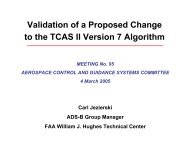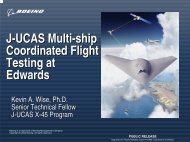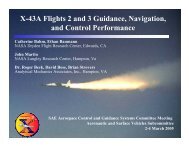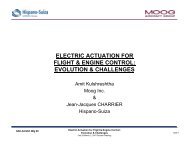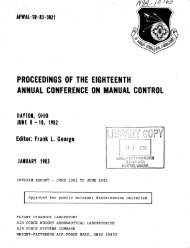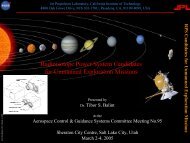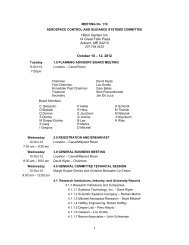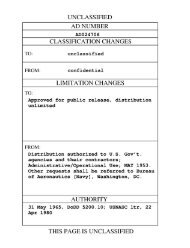Report of the Second Piloted Aircraft Flight Control System - Acgsc.org
Report of the Second Piloted Aircraft Flight Control System - Acgsc.org
Report of the Second Piloted Aircraft Flight Control System - Acgsc.org
Create successful ePaper yourself
Turn your PDF publications into a flip-book with our unique Google optimized e-Paper software.
changing flight corditions. Idea-, one would design dynamic compensation<br />
networks, as suggested in some <strong>of</strong> <strong>the</strong> earlier talks--compensation networks<br />
which would be automatically compensated for c-ng longitudinal velocity,<br />
eta. If <strong>the</strong> compensation is effected entirely electricalJy, thle dynamic<br />
cornpensat ion can be approximated fairly well, although <strong>the</strong> complexity <strong>of</strong> <strong>the</strong><br />
instrumentation necessarily is greater than with a linear qystem. If as we<br />
have tried to suggest in <strong>the</strong> past fm moments, <strong>the</strong> campensation is effected<br />
hydraulically and mechanically, dynamic compensation is a more difficult<br />
problem. Ae yet we have done nothing along this line.<br />
I would like to summarize briefly. We feel that <strong>the</strong> time is rapidly<br />
approaching when <strong>the</strong> stability and controllability problems <strong>of</strong> design will<br />
be <strong>of</strong> paramount importance. We feel that it is essential that logical<br />
design procedures be established in anticipation <strong>of</strong> <strong>the</strong>se difficulties.<br />
logical desiep prodwe must proceed from quantitative 8pecifications.<br />
It must lead to suitable general networks for accomplishing <strong>the</strong> cornpeneation.<br />
We feel that conpensation system can be determined which will essentially<br />
force <strong>the</strong> airplane to meet <strong>the</strong> selected performance specifications. The<br />
realization <strong>of</strong> <strong>the</strong>se compensation systems can be accoqlished electronically.<br />
We al8o feel that compensation can be effected hydraulically and mechanically.<br />
We believe that <strong>the</strong>re is a great deal <strong>of</strong> work yet to be done in evaluating<br />
various Q-draulic-mechanical systems for compensation, in studying <strong>the</strong><br />
effects <strong>of</strong> various locations <strong>of</strong> <strong>the</strong>se networks in <strong>the</strong> overall system, in<br />
considering <strong>the</strong> poabibillty <strong>of</strong> using parallel compensation, and in <strong>the</strong><br />
related probldl~lb.<br />
The system. I have ueed throughout this paper as an ~ l <strong>of</strong> some e <strong>of</strong><br />
<strong>the</strong>se ideas is about as simple a system as one can devime to scoomplish even<br />
<strong>the</strong>oretically <strong>the</strong> desired control. We feel that it is essential that mare<br />
complar (and reallatie) system8 be considered from this standpoint <strong>of</strong><br />
stabillaation devices. appreciable complication <strong>of</strong> <strong>the</strong> system will<br />
necessitate going to computer and simulator studies, as <strong>the</strong> introduction<br />
<strong>of</strong> additional degrees <strong>of</strong> freedom rapidly places <strong>the</strong> complex it^ <strong>of</strong> <strong>the</strong> wstsa<br />
beyond <strong>the</strong> bounds <strong>of</strong> human comprehension. Thus far, we have not done Whlq<br />
appreciable with d o g computer studies, as we have felt that intelligent us.<br />
<strong>of</strong> ccenputer data required a solid understanding and background in <strong>the</strong> behavior<br />
<strong>of</strong> simpler elystams.



